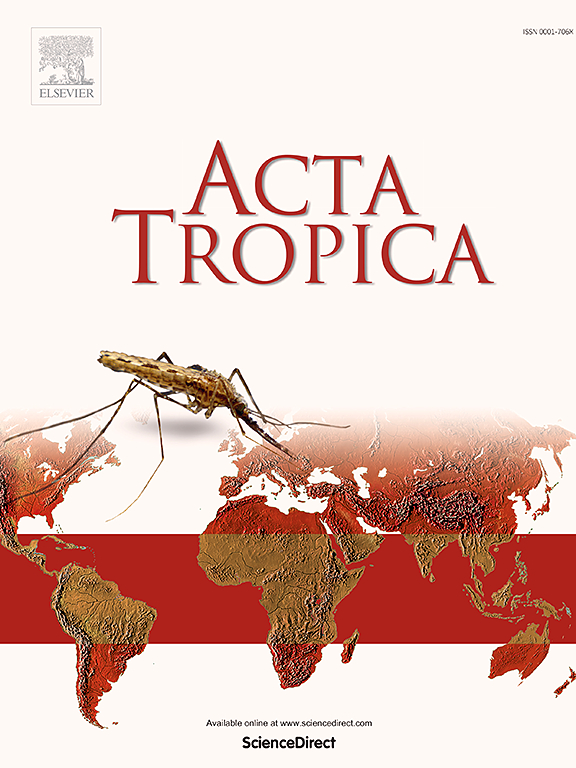哈布毒蛇(Protobothrops flavoviridis)是亚热带亚洲人畜共患病蜱虫Amblyomma testudinarium(Acari: Ixodidae)的一个被忽视但却重要的贮藏库。
IF 2.1
3区 医学
Q2 PARASITOLOGY
引用次数: 0
摘要
亚洲亚热带地区拥有丰富多样的爬行动物和蜱虫,但爬行动物在该地区具有重要医疗价值的蜱虫的寄生周期中所起的作用却鲜为人知。哈布蝮蛇(Protobothrops flavoviridis)在日本亚热带地区广泛分布,十分常见,但它们作为蜱虫宿主的作用尚未得到仔细研究。在 2023/24 年的 15 个月中,对哈布蝰进行了蜱虫筛查,发现它们是蜱虫 Amblyomma testudinarium 未成年阶段的重要宿主,感染率为 22%。研究发现,Amblyomma testudinarium对P. flavoviridis的附着部位偏好较弱,宿主体长与受感染蛇类的感染风险或蜱载量均无关系。根据黄花蜱的平均负载量和历史标记数据,首次绘制了亚热带地区黄花蜱的物候轮廓图。结果表明,3 月至 4 月是活动最频繁的时期,5 月至 7 月是活动减少的时期,8 月至 9 月是几乎完全不活动的时期,10 月至 2 月是活动增加的时期。本文讨论了哈布蝰在亚洲亚热带地区睾丸蝮蛇活动周期中的作用。此外,还探讨了哈布蝰作为病原体储库或稀释宿主的潜力。本文章由计算机程序翻译,如有差异,请以英文原文为准。
Habu vipers (Protobothrops flavoviridis) are an overlooked but important reservoir of the zoonotic tick Amblyomma testudinarium (Acari: Ixodidae) in subtropical Asia
Subtropical Asia has a rich diversity of reptiles and ticks, though the role of reptiles in the sylvatic cycles of medically important ticks in the region is poorly known. Habu vipers (Protobothrops flavoviridis) are widespread and common in the Japanese subtropics but their role as hosts for ticks has not been carefully explored. For 15 months in 2023/24, habu vipers were screened for ticks and were found to be important hosts for immature stages of the tick Amblyomma testudinarium, with a 22 % infestation rate. Amblyomma testudinarium was found to have weak attachment site preferences on P. flavoviridis and host body length was found to have no relationship with either the risk of infestation or the tick load in infested snakes. The phenological profile of A. testudinarium was mapped for the first time in the subtropics based on mean tick loads on P. flavoviridis and historical flagging data. March-April were identified as the period of highest activity, May to July was a period of declining activity, August-September was a period of almost complete inactivity, and October to February was a periods of increasing activity. The role of habu vipers in the sylvatic cycle of A. testudinarium in subtropical Asia is discussion. Additionally, the potential of habu vipers to serve as reservoirs of pathogens or as dilution hosts is also explored.
求助全文
通过发布文献求助,成功后即可免费获取论文全文。
去求助
来源期刊

Acta tropica
医学-寄生虫学
CiteScore
5.40
自引率
11.10%
发文量
383
审稿时长
37 days
期刊介绍:
Acta Tropica, is an international journal on infectious diseases that covers public health sciences and biomedical research with particular emphasis on topics relevant to human and animal health in the tropics and the subtropics.
 求助内容:
求助内容: 应助结果提醒方式:
应助结果提醒方式:


